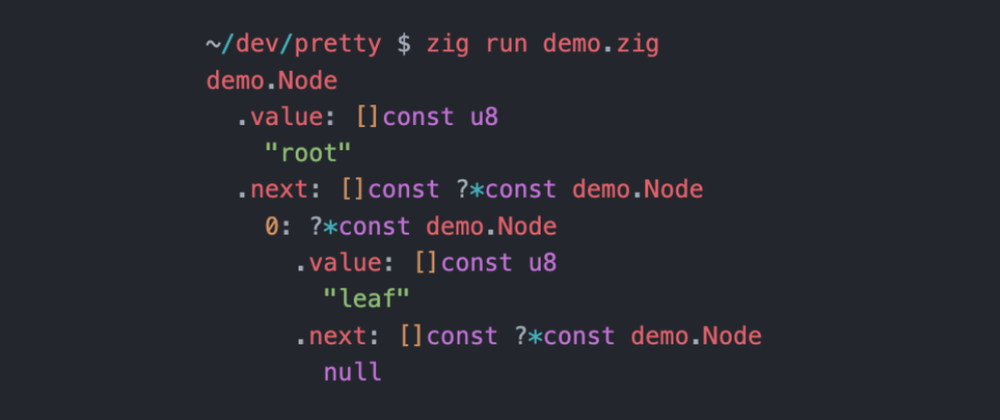I'm excited* to publish my first Zig project – pretty, a simple pretty printer for inspecting complex and deeply-nested data structures.
I developed it as part of my language project to inspect complex trees (AST). Later on, I realized how useful it is on its own. So, I spent a couple of months honing it. With various printing options, you can almost "query" the things you want to see in your data. While it doesn't yet support every type for laying out things nicely, I believe I covered the most important ones. Feel free to check it out!
Here is the demo (excerpt from the repo):
simplified version of src/demo.zig:
// main.zig
const std = @import("std");
const pretty = @import("pretty.zig");
const alloc = std.heap.page_allocator;
pub fn main() !void {
const array = [3]u8{ 4, 5, 6 };
// method 1: print with default options
try pretty.print(alloc, array, .{});
// method 2: customize your print
try pretty.print(alloc, array, .{
.arr_show_item_idx = false,
.arr_max_len = 2,
});
// method 3: don't print, get a string!
var out = try pretty.dump(alloc, array, .{});
defer alloc.free(out);
std.debug.print("{s}..\n", .{out[0..5]});
}
output:
$ zig run main.zig
[3]u8
0: 4
1: 5
2: 6
[3]u8
4
5
[3]u8..
*Zig's Discord server and ziggit.dev forum helped me immensely to get through the hard times of learning Zig. The effort I put into making the utility I use myself reusable for others is my humble way of saying thank you to the community. Plus, I made my first donation today. So, thank you guys a lot!







Top comments (4)
Thanks for sharing this! It will be very useful when write tests, or do printing debugging. And by reading it, I just discovered the excellent
std.metanamespace, so many useful functions over there.no color?
I for one am thankful for the lacking support of this feature; this would mean supporting color schemes as well and a way to streamline the user's custom printing and the library's printing; IMO: immediately messy.
Distinguishing the color display is just icing on the cake.